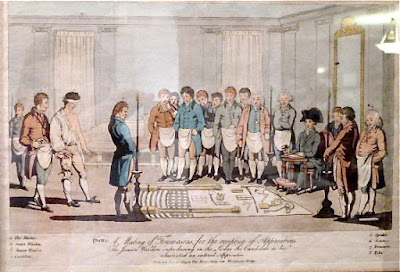 |
Magpie file photo
Eighteenth century French engraving depicting First Degree ritual on display at the Livingston Library in Masonic Hall.
|
On Friday, Garibaldi Lodge 542 will meet in the Grand Lodge Room to confer its famous Entered Apprentice Degree. This is the French Rite ritual, entrusted to Garibaldi by l’Union Française Lodge 17, that Garibaldi works in Italian. It is heavy with alchemical and Rosicrucian meanings that one would expect in a European Masonic initiation, and near the end of the ceremony, the Youngest Entered Apprentice has thrust upon him a jolting moment of clarity.
Today is the last day of National Poetry Month. Launched in 1996 by the Academy of American Poets, the celebration highlights the importance of poetry to us all by reading, by honoring poets past and present, by sharing books of poems, and by organizing support for poets and poetry. With this in mind, here is a great from 100 years ago.
That mirror
Which makes of men a transparency,
Who holds that mirror
And bids us such a breast-bared spectacle to see
Of you and me?
That mirror
Whose magic penetrates like a dart,
Who lifts that mirror
And throws our mind back on us, and our heart,
Until we start?
That mirror
Works well in these night hours of ache;
Why in that mirror
Are tincts we never see ourselves once take
When the world is awake?
That mirror
Can test each mortal when unaware;
Yea, that strange mirror
May catch his last thoughts, whole life foul or fair,
Reflecting it—where?























































































